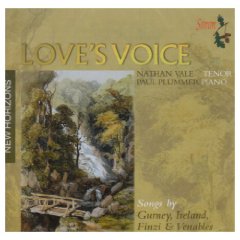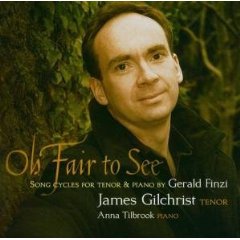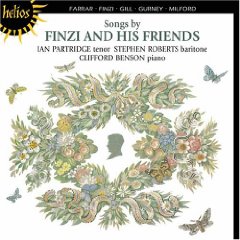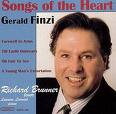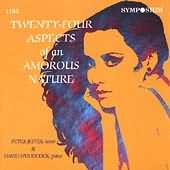Since we loved
Poet: Robert Bridges
Date of poem: (undated)
Publication date: In the collection entitled: Poetical Works of Robert Bridges excluding the eight dramas, 1899.
Publisher: Smith, Elder & Company
Collection: Poetical Works of Robert Bridges excluding the eight dramas
History of Poem: Collected for the first time in 1899. Smith, Elder & Co. Vol. II. The poem can be found in: Poetical Works of Robert Bridges excluding the eight dramas. It is untitled in a section entitled "New Poems" appearing simply as number sixteen. There are a total of twenty-eight poems within "New Poems" and they vary in length from a few pages to a couple of stanzas like this one.
(Bridges, 322)
Poem
| 1 | SINCE we loved, - (the earth that shook | a |
| 2 | As we kissed, fresh beauty took) – | a |
| 3 | Love hath been as poets paint, | b |
| 4 | Life as heaven is to a saint; | b |
| 5 | All my joys my hope excel, | c |
| 6 | All my work hath prosper’d well, | c |
| 7 | All my songs have happy been, | d |
| 8 | O my love, my life, my queen. | d |
Content/Meaning of the Poem:
1st stanza: Love has taken on a new meaning since we have kissed and fallen deeply in love. It is the love often spoken by poets and the joy of life as pure as a saint;
2nd stanza: All my joy and hope have grown, all my work has been fruitful, all of my songs are happy, because of you, my love, my life, my queen.
Speaker: Possibly the poet
Setting: No particular setting is indicated one may assume that these lines flow from the mind of the poet and are non-specific as to location.
Purpose: Love crosses all boundaries and makes life full of joy.
Idea or theme: Love
Style: Written in a lyrical style.
Form:Two quatrains with pairs of rhyming lines, for example, aa bb cc dd.
Synthesis: When one falls in love and remains deeply devoted and infatuated with ones spouse, life seems to be all rosy or at least in the eyes of Robert Bridges. The poem is one to lift the spirits and remind the reader that through love life is incredibly joyful. The first three lines of the last stanza seem to paint the picture that because of this incredible love that the speaker has he cannot do anything wrong. One could say that he is blind to all mistakes and problems because life when one is in love is all warm and rosy.
✦✼✦✼✦✼✦✼✦✼✦✼✦✼✦✼✦✼✦✼✦✼✦✼✦✼✦✼✦✼✦✼✦✼✦
Musical Analysis
Composition date: The song was completed by Gerald Finzi on August 28, 1956.
(Banfield, 478) The composition was Finzi's last before his death one month later on September 27, 1956. (Banfield, 482)
Publication date: First published 1965 - © Copyright 1966 by Boosey and Co. Ltd.
Publisher: Boosey & Hawkes - distributed by Hal Leonard Corporation
Tonality: G major
Transposition: The song is available in E Major a minor third lower than the original key. The transposed version may be found in the Medium/Low Voice edition by Boosey & Hawkes entitled: Gerald Finzi Collected Songs 54 Songs Including 8 Cycles or Sets.
Duration: Approximately one minute and twenty-six seconds.
Meter: There are three types of meter used within the song: 3/4 is used in nine measures; 4/4 is used in six measures; 5/4 is used only once in measure fourteen. 4/4 is used exclusively in single measures throughout the song except at the conclusion. 3/4 dominates the first stanza with six occurrences but shares equal footing with 4/4 for the last stanza at four measures each.
Tempo: The tempo indicated is Andante sostenuto with the quarter note equalling 60. There are no deviations from the given tempo until the last measure where a ritard is indicated for the piano.
Form: The song is through-composed and is comprised mainly of small phrases or fragments. The piano accompaniment in the first two measures and the postlude are identical except for the final cadence, as such they act as bookends and offer the sole unifying material within the song (see examples below).
Piano accompaniment in first two measures. (Finzi, 84)

Piano postlude, final two measures. (Finzi, 85)
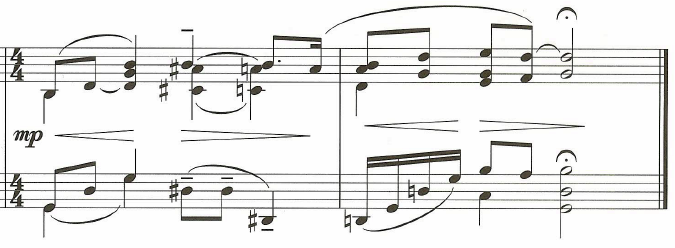
The text for the second stanza of the poem begins in measure seven and prior to this Finzi creates some harmonic tension briefly with the use of a D-sharp and D-natural in the left hand of the piano accompaniment. He resolves the tension to a tonic chord in second inversion on the third beat of measure seven to begin the second stanza (see example below).
Harmonic tension in measure 7. (Finzi, 85)
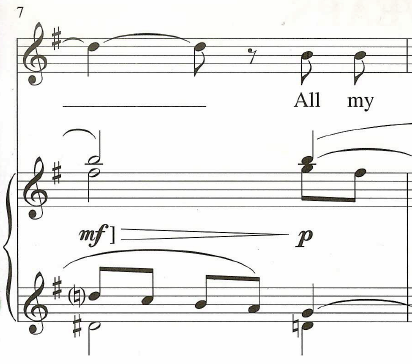
The use of chromaticism is limited to the piano accompaniment for the beginning two measures and the postlude with one exception, the D-sharp in measure seven. The song has very little harmonic tension except for the brief occurrence in measure seven, as such this adds significance to this single occurrence which helps separate the two stanzas. Finzi writes a dominant chord in third inversion for the final cadence of the song. This is standard practice for him as he quite often steers clear of a dominant to tonic, nevertheless it is a full cadence, albeit a weak one.
Rhythm: This is a very simple song, rhythmically, with a very subtle rhythmic motif comprised of two eights followed by various rhythmic durations (see examples below).
Rhythmic motif in measure 1. (Finzi, 84)

Rhythmic motif in measure 5. (Finzi, 84)
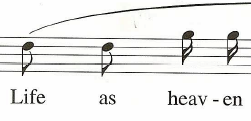
Rhythmic motif in measures 7-8. (Finzi, 85)

Rhythmic motif in measures 12-3. (Finzi, 85)

The beginning of each line of poetry except for the second line is begun using the rhythmic motif and as such offers some unification, rhythmically. The one exception, mentioned above, is the second line of poetry. This line is part of an aside placed within parentheses and here, Finzi places no emphasis whatsoever on the text: "as we kissed" (see example below).
Beginning of the second line of the poem in measure 2. (Finzi, 84)

The opening tempo is indicated with a quarter note pulse but most of the song has a steady eighth note pulse. To find exceptions to the eighth note pulse one must look to the last lines of the text in measures twelve through fourteen. Here, Finzi slows the rhythmic pulse down in order to conclude the poem (see example below).
Rhythmic pulse slowed in measures 12-4. (Finzi, 85)

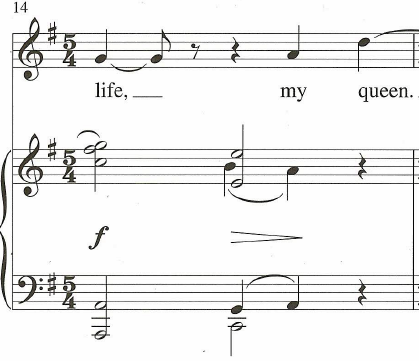
A rhythmic duration analysis was performed and for the results please refer to: Rhythm Analysis. Information contained within the analysis includes: the number of occurrences a specific rhythmic duration was used; the phrase in which it occurred; the total number of occurrences in the entire song.
Melody: The melodic material found in the song primarily consists of step wise motion accompanied with small leaps, larger leaps are found as well but they are reserved for special significance such as text support. The largest leaps in the vocal line are found in measures twelve and thirteen with the text "O my love, my." Finzi writes an ascending minor seventh followed by a descending octave here in support of the text (see example below).
Leaps of an ascending minor seventh and a descending octave in measures 12-3. (Finzi, 85)

A typical Finzi vocal line consists of step-wise motion and small leaps normally and often times create small arches. This song follows this pattern for the most part but in measure ten the motion is not typical. Here one will find several leaps in succession in opposite direction from one another, an up down up down up motion. The motion begins with the last eighth note of measure nine and concludes on the third beat of measure ten. The same type of motion is again seen in the measures eleven and twelve (see examples below).
Disjunct motion in measures 9-12 in the vocal line. (Finzi, 85)
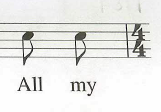


These two small melodic passages may seem insignificant but with the text in mind, "All my work hath prosper'd well," and "All my songs have happy been," the melodic motion doesn't seem to portray joy or happiness. Perhaps Finzi's sarcasm or dry sense of humor is at work here in these disjunct melodic passages and possibly the melody is more true to life than the words.
An interval analysis was performed for the purpose of discovering the number of occurrences specific intervals were used and also to see the similarities if there were any between stanzas. Only intervals larger than a major second were accounted for in the interval analysis. For a complete description of the results of the interval analysis please see the table at the bottom of the page or click on the link: Interval Analysis.
Texture: The song has a homophonic texture throughout.
Vocal Range: The vocal range is one octave. The lowest pitch is the G below middle C and the highest pitch is the G above middle C. The song is also available a minor third lower in the Medium/Low Voice edition by Boosey & Hawkes entitled: Gerald Finzi Collected Songs 54 Songs Including 8 Cycles or Sets.
Tessitura: The tessitura of the song encompasses the entire range of the song which is one octave. For a complete pitch count for each stanza please refer to: Pitch Analysis.
Dynamic Range: The dynamics range from piano to forte. Primarily the song is at the low piano dynamic with a crescendo to forte reserved for the climax in measures thirteen and fourteen.
Accompaniment: The accompaniment has frequent thirds and full chords in the right hand. Almost every measure has some dynamic change but all in all the accompaniment is not difficult.
Published comments about the music: Stephen Banfield in his Finzi biography makes the following comments: "Finzi cannot have known or guessed that this would be his last composition [Since we loved], for when the end came it was swift and without warning. Yet nor could he have written a more beautiful and perfect final love letter to Joy, to his art, and to life itself (even if the line 'All my songs have happy been' is glaringly untrue!), and the last music he ever wrote has an almost unbearably simple poignancy." (Banfield, 478)
Pedagogical Considerations for Voice Students and Instructors: The tessitura for this song, in the original key, is a little higher than the remaining songs in the set but with this in mind the song could make for an a good pedagogical lesson on passaggio. The song is not very long and this should help most students that struggle with passaggio issues. There are also ample opportunities in this song for the singer to mismanage their breath support and/or to elevate the larynx. In order to combat these potential problems slow the tempo down and take extra time to gather the breath between phrases. Once the breath is comfortable the tempo can be accelerated. With regards to elevating the larynx, the student may also need some coaching on vowel modification and this may help in tandem with breath management.
✦✼✦✼✦✼✦✼✦✼✦✼✦✼✦✼✦✼✦✼✦✼✦✼✦✼✦✼✦✼✦✼✦✼✦
| Pitch Analysis | ||||
|---|---|---|---|---|
| pitch | stanza 1 |
stanza 2 |
total | |
highest |
G |
3 |
2 |
5 |
F |
0 |
|||
E |
2 |
3 |
5 |
|
D |
10 |
4 |
14 |
|
middle C |
4 |
3 |
7 |
|
B |
6 |
6 |
12 |
|
A |
3 |
5 |
8 |
|
lowest |
G |
1 |
5 |
6 |
✦✼✦✼✦✼✦✼✦✼✦✼✦✼✦✼✦✼✦✼✦✼✦✼✦✼✦✼✦✼✦✼✦✼✦
Audio Recordings
The English Song Series - 16 |
|
|
|
Love's Voice |
|
|
|
Song Cycles for Tenor & Piano by Gerald Finzi |
|
|
|
Song by Finzi and His Friends |
|
|
|
On This Island |
|
|
|
Oh Fair to See: Songs by English composers |
|
|
|
Songs of the Heart: Song Cycles of Gerald Finzi |
|
|
|
The English Songbook |
|
|---|---|
|
|
Twenty-Four Aspects of an Amorous Nature |
|
|
|
The Very Best of English Song |
|
|---|---|
|
|


